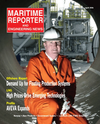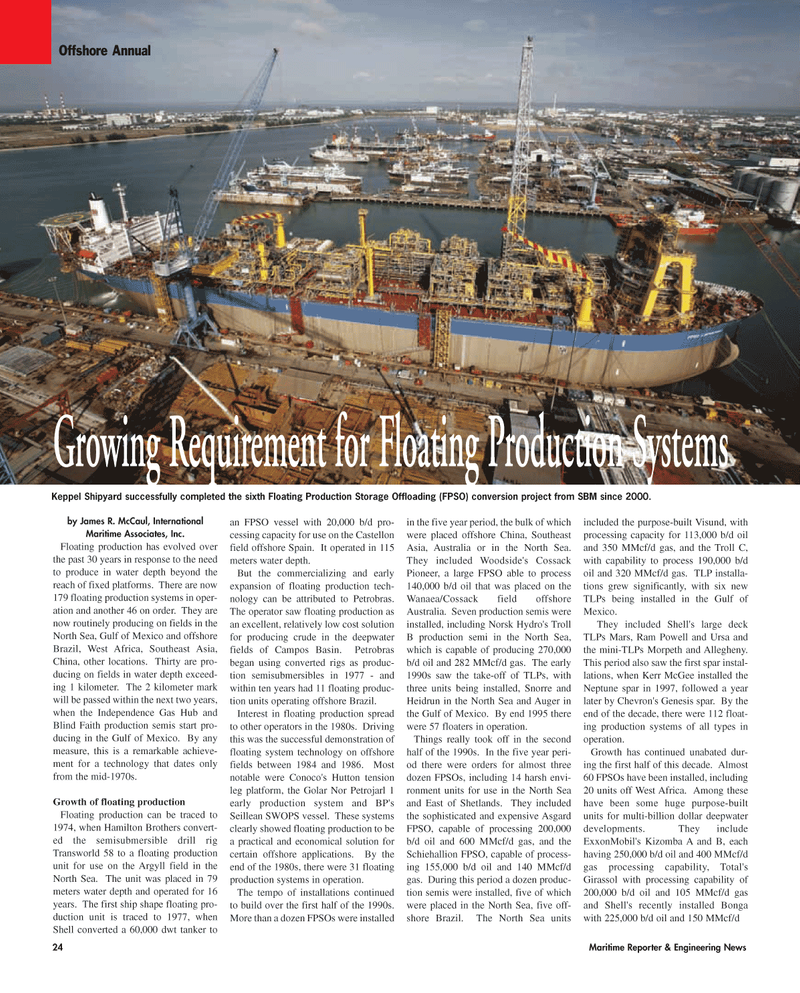
Page 24: of Maritime Reporter Magazine (April 2006)
The Offshore Industry Annual
Read this page in Pdf, Flash or Html5 edition of April 2006 Maritime Reporter Magazine
24 Maritime Reporter & Engineering News by James R. McCaul, International
Maritime Associates, Inc.
Floating production has evolved over the past 30 years in response to the need to produce in water depth beyond the reach of fixed platforms. There are now 179 floating production systems in oper- ation and another 46 on order. They are now routinely producing on fields in the
North Sea, Gulf of Mexico and offshore
Brazil, West Africa, Southeast Asia,
China, other locations. Thirty are pro- ducing on fields in water depth exceed- ing 1 kilometer. The 2 kilometer mark will be passed within the next two years, when the Independence Gas Hub and
Blind Faith production semis start pro- ducing in the Gulf of Mexico. By any measure, this is a remarkable achieve- ment for a technology that dates only from the mid-1970s.
Growth of floating production
Floating production can be traced to 1974, when Hamilton Brothers convert- ed the semisubmersible drill rig
Transworld 58 to a floating production unit for use on the Argyll field in the
North Sea. The unit was placed in 79 meters water depth and operated for 16 years. The first ship shape floating pro- duction unit is traced to 1977, when
Shell converted a 60,000 dwt tanker to an FPSO vessel with 20,000 b/d pro- cessing capacity for use on the Castellon field offshore Spain. It operated in 115 meters water depth.
But the commercializing and early expansion of floating production tech- nology can be attributed to Petrobras.
The operator saw floating production as an excellent, relatively low cost solution for producing crude in the deepwater fields of Campos Basin. Petrobras began using converted rigs as produc- tion semisubmersibles in 1977 - and within ten years had 11 floating produc- tion units operating offshore Brazil.
Interest in floating production spread to other operators in the 1980s. Driving this was the successful demonstration of floating system technology on offshore fields between 1984 and 1986. Most notable were Conoco's Hutton tension leg platform, the Golar Nor Petrojarl 1 early production system and BP's
Seillean SWOPS vessel. These systems clearly showed floating production to be a practical and economical solution for certain offshore applications. By the end of the 1980s, there were 31 floating production systems in operation.
The tempo of installations continued to build over the first half of the 1990s.
More than a dozen FPSOs were installed in the five year period, the bulk of which were placed offshore China, Southeast
Asia, Australia or in the North Sea.
They included Woodside's Cossack
Pioneer, a large FPSO able to process 140,000 b/d oil that was placed on the
Wanaea/Cossack field offshore
Australia. Seven production semis were installed, including Norsk Hydro's Troll
B production semi in the North Sea, which is capable of producing 270,000 b/d oil and 282 MMcf/d gas. The early 1990s saw the take-off of TLPs, with three units being installed, Snorre and
Heidrun in the North Sea and Auger in the Gulf of Mexico. By end 1995 there were 57 floaters in operation.
Things really took off in the second half of the 1990s. In the five year peri- od there were orders for almost three dozen FPSOs, including 14 harsh envi- ronment units for use in the North Sea and East of Shetlands. They included the sophisticated and expensive Asgard
FPSO, capable of processing 200,000 b/d oil and 600 MMcf/d gas, and the
Schiehallion FPSO, capable of process- ing 155,000 b/d oil and 140 MMcf/d gas. During this period a dozen produc- tion semis were installed, five of which were placed in the North Sea, five off- shore Brazil. The North Sea units included the purpose-built Visund, with processing capacity for 113,000 b/d oil and 350 MMcf/d gas, and the Troll C, with capability to process 190,000 b/d oil and 320 MMcf/d gas. TLP installa- tions grew significantly, with six new
TLPs being installed in the Gulf of
Mexico.
They included Shell's large deck
TLPs Mars, Ram Powell and Ursa and the mini-TLPs Morpeth and Allegheny.
This period also saw the first spar instal- lations, when Kerr McGee installed the
Neptune spar in 1997, followed a year later by Chevron's Genesis spar. By the end of the decade, there were 112 float- ing production systems of all types in operation.
Growth has continued unabated dur- ing the first half of this decade. Almost 60 FPSOs have been installed, including 20 units off West Africa. Among these have been some huge purpose-built units for multi-billion dollar deepwater developments. They include
ExxonMobil's Kizomba A and B, each having 250,000 b/d oil and 400 MMcf/d gas processing capability, Total's
Girassol with processing capability of 200,000 b/d oil and 105 MMcf/d gas and Shell's recently installed Bonga with 225,000 b/d oil and 150 MMcf/d
Offshore Annual
Growing Requirement for Floating Production Systems
Keppel Shipyard successfully completed the sixth Floating Production Storage Offloading (FPSO) conversion project from SBM since 2000.
MR APRIL2006 #3 (17-24).qxd 4/3/2006 11:16 AM Page 24

 23
23

 25
25
